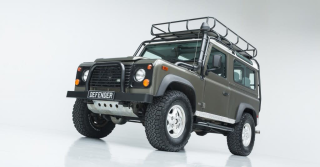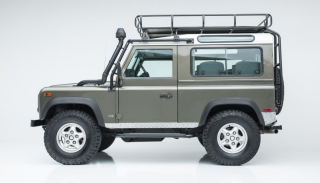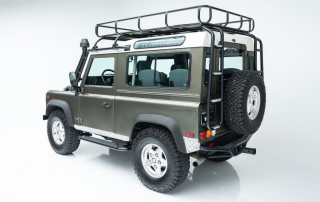The Good
The 1997 Land Rover Defender offers unparalleled off-road performance and a timeless, functional design. Its robust ladder-frame chassis and solid axles ensure extreme durability, appealing to practical buyers seeking a true workhorse. Emotionally, it provides a sense of adventure and exclusivity, becoming a symbol of rugged individuality and heritage. Its simplicity also makes it relatively easy to maintain for enthusiasts.
The Bad
Known weaknesses of the 1997 Land Rover Defender include its agricultural on-road comfort, notoriously poor fuel economy, and occasional electrical gremlins. Rust, especially on the frame and bulkhead, is a common concern due to age. Parts availability can be challenging for some specific NAS components, and certain leaks, particularly from the transfer case or engine, are frequently reported.
1997 Land Rover Defender: Quick Overview
- Engine Options: For the North American Specification (NAS) 1997 Land Rover Defender 90, the primary and virtually sole engine offered was a 4.0-liter Rover V8 engine. This fuel-injected, naturally aspirated gasoline engine provided a good balance of power for its intended off-road use, distinguishing it from the diesel engines common in other markets.
- Horsepower: The 4.0L V8 engine produced approximately 182-188 horsepower (hp) and around 232-236 lb-ft of torque. This output, while not class-leading by modern standards, was sufficient to move the Defender's substantial weight, especially when coupled with its capable four-wheel-drive system and low-range gearing for tackling challenging terrain.
- Fuel Economy: Fuel economy for the V8-powered 1997 Defender was notably low, reflecting its heavy-duty construction and less aerodynamic design. Owners could expect figures in the single digits to low double digits, typically ranging from about 10-13 miles per gallon (MPG) combined, making it a thirsty vehicle for daily driving.
- 0-60 Times: Performance on pavement was not the Defender's strong suit. The 0-60 mph acceleration time was relatively leisurely, generally taking between 10 to 12 seconds. This characteristic emphasizes its purpose as a rugged utility vehicle rather than a performance-oriented SUV, prioritizing torque and capability over speed.
- Towing Capacity: The 1997 Land Rover Defender 90 (NAS) had a respectable towing capacity, often rated around 5,000 pounds (approximately 2,268 kg) when properly equipped. Its robust chassis and powerful V8 engine made it capable of hauling trailers, though its relatively short wheelbase for the D90 might have limited stability with very heavy loads.
- Trim-Level Features: The NAS 1997 Defender 90 was offered primarily in soft-top and hard-top configurations, rather than distinct trim levels with varying feature packages like modern vehicles. Standard features for the NAS models were surprisingly comprehensive for an off-roader of its era, including a full-time four-wheel-drive system, a lockable center differential, air conditioning, a roll cage (for soft-top), and alloy wheels. Safety features included dual front airbags and four-wheel anti-lock brakes (ABS). Power windows and mirrors were also standard, adding a touch of convenience to its utilitarian nature. A basic AM/FM cassette stereo was typically included, along with seating for up to six in the D90 soft-top thanks to rear jump seats.
1997 Land Rover Defender Specifications
Vehicle Information
| Year | 1997 |
| Make | Land Rover |
| Model | Defender |
| Trim | - |
| Style | Sedan V-8 |
| Type | Sedan |
| Category | - |
Manufacturing Details
| Made In | - |
| Manufacturing City | - |
Dimensions
| Doors | - |
| Curb Weight | - |
| Gross Vehicle Weight Rating | - |
| Overall Height | - |
| Overall Length | - |
| Overall Width | - |
| Wheelbase Length | - |
| Standard Seating | - |
Engine & Performance
| Engine | - |
| Engine Size | - |
| Engine Cylinders | 8 |
| Transmission | - |
| Transmission Type | - |
| Transmission Speeds | - |
| Drivetrain | - |
Additional Features
| Anti-Brake System | - |
| Steering Type | - |
Pricing
| Manufacturer Suggested Retail Price (MSRP) | - |
| Invoice Price | - |
| Delivery Charges | - |
Vehicle History Report
Specifications
History
Events
History Check
Check
Check
Check
Check
Listings
Recalls
Check
Analysis
What Problems Does the 1997 Land Rover Defender Have?
Fluid leaks are almost a "feature" of older Defenders. Owners frequently report oil leaks from the engine (especially the rear main seal or valve cover gaskets of the Rover V8), power steering fluid leaks, and leaks from the transfer case or differentials. While not always critical, they indicate ongoing maintenance needs.
Electrical gremlins are another well-known Defender characteristic. Issues can range from intermittent gauges, faulty lights, problematic window switches, to issues with the alarm system or central locking. These often stem from aging wiring, poor grounding, or corroded connections.
The 4.0L V8 engine, while generally robust, can suffer from cooling system issues if not properly maintained, leading to overheating. Head gasket failures, while not as common as in earlier 3.9L engines, are still a possibility, particularly if overheating has occurred.
Drivetrain components like U-joints, swivel hubs, and ball joints require regular greasing and inspection; wear in these areas can lead to steering play or vibrations. The manual R380 gearbox (if fitted, though most NAS D90s were automatic) can have synchro issues, and the automatic ZF 4HP22 transmission, while reliable, can develop minor fluid leaks or harsh shifts if neglected.
No significant recalls specific to the 1997 NAS Land Rover Defender 90 are widely documented for critical safety issues. Most concerns are related to wear, tear, and the specific quirks of a 25+ year-old specialized vehicle. Long-term reliability is achievable with diligent maintenance, but it demands an owner prepared for continuous attention to these known issues. The '97 model year benefits from the refinements made over the Defender's production run, but it still shares many underlying design elements prone to these classic problems.
How long will the 1997 Land Rover Defender last?
What Technology & Safety Features are Included?
Built-in Tech: The most significant technological inclusion for the NAS models was the 4.0-liter V8 engine with electronic fuel injection (EFI), providing more consistent power delivery and efficiency compared to carbureted setups. Full-time four-wheel drive with a lockable center differential was standard, a crucial piece of "tech" for its off-road prowess, manually engaged by the driver.
Entertainment: Entertainment features were rudimentary. A basic AM/FM cassette stereo was typically the extent of the factory offerings. There was no integrated CD player, satellite radio, or advanced sound systems. Owners often upgrade these systems significantly with aftermarket units to meet modern expectations.
Driver-Assistance: Driver-assistance features as we know them today were entirely absent. There was no traction control, stability control, blind-spot monitoring, cruise control, or parking sensors. Driving the Defender was a very direct, mechanical experience requiring full driver engagement.
Safety Features: For its time and class, the NAS 1997 Defender 90 offered reasonable safety features. It came standard with dual front airbags (driver and passenger), a significant upgrade over earlier models or those in other markets. Four-wheel anti-lock brakes (ABS) were also standard, providing improved stopping power and control on varied surfaces. The sturdy ladder frame chassis and robust body-on-frame construction offered inherent passive safety, particularly in low-speed impacts or rollovers, especially for soft-top models equipped with an external roll cage. However, side airbags, crumple zones, or advanced occupant protection systems were not present.
Optional Features: While 'trims' were minimal, options primarily revolved around accessories for utility and off-roading, such as winches, roof racks, brush guards, rock sliders, and upgraded lighting.
Crash-Test Ratings: Official crash-test ratings from organizations like NHTSA or IIHS for a vehicle of this age and limited production volume (especially for the NAS market) are not available. Its design predates modern crash-test standards, meaning it would likely fare poorly against contemporary vehicles, despite its perceived robustness.
What Colors Options are Available?
1997 Land Rover Defender Prices and Market Value
1997 Land Rover Defender Cost of Ownership
1997 Land Rover Defender Fuel Efficiency
1997 Land Rover Defender Insurance
reasonable repair costs.
How Does the 1997 Land Rover Defender Compare to Other Sedan?
In terms of performance, the Defender offers exceptional off-road capability, often surpassing the Land Cruiser and Wrangler in extreme terrain due to its robust construction, short overhangs (D90), and permanent 4x4 with lockable center differential. However, on-road performance and comfort are significantly behind the more refined Land Cruiser and G-Wagen, and even the Wrangler offers a slightly more compliant ride. Its V8 provides decent power, but the Land Cruiser's inline-six is often smoother and more reliable, while the G-Wagen's engines are typically more powerful.
Features in the Defender are sparse; it's a utilitarian machine. The Land Cruiser 80-series offered significantly more creature comforts, a quieter cabin, and better build quality in terms of fit and finish. The Wrangler, similarly basic, was still often seen as a more 'fun' open-air experience, though less robust. The G-Wagen was luxurious by comparison, with advanced (for the time) features and superior interior materials. The Defender's primary 'feature' is its raw capability.
Reliability is a mixed bag. The Defender is mechanically robust but prone to rust, leaks, and electrical issues, demanding a proactive owner. The Toyota Land Cruiser 80-series is legendary for its bulletproof reliability and often lasts for hundreds of thousands of miles with minimal fuss, making it a stronger contender in this regard. The Jeep Wrangler also has its quirks but is generally easier and cheaper to fix. The G-Wagen, while well-built, can have complex and expensive repairs.
Price is where the Defender has surged. While the Land Cruiser and G-Wagen have also appreciated, the NAS Defender's scarcity and iconic status have driven its price to often exceed even well-preserved G-Wagens of the same era, and certainly any Wrangler or Land Cruiser.
Alternatives: For pure off-road capability without the Defender's current premium, a well-maintained Toyota Land Cruiser FZJ80 is a strong alternative, offering similar ruggedness with better on-road manners and legendary reliability. For a more modern yet still capable experience, the Jeep Wrangler Rubicon offers significant off-road prowess. If luxury and capability are both priorities and budget is less of a concern, a classic Mercedes-Benz G-Wagen is an option.





